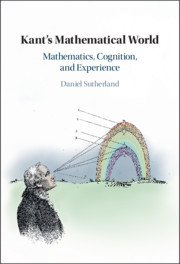Book contents
- Kant’s Mathematical World
- Kant’s Mathematical World
- Copyright page
- Dedication
- Contents
- Preface and Acknowledgments
- 1 Introduction
- Part I Mathematics, Magnitudes, and the Conditions of Experience
- 2 Space, Time, and Mathematics in the Critique of Pure Reason
- 3 Magnitudes, Mathematics, and Experience in the Axioms of Intuition
- 4 Extensive and Intensive Magnitudes and Continuity
- 5 Conceptual and Intuitive Representation
- Interlude The Greek Mathematical Tradition as Background to Kant
- Part II Kant’s Theory of Magnitudes, Intuition, and Measurement
- Bibliography
- Index
4 - Extensive and Intensive Magnitudes and Continuity
from Part I - Mathematics, Magnitudes, and the Conditions of Experience
Published online by Cambridge University Press: 21 October 2021
- Kant’s Mathematical World
- Kant’s Mathematical World
- Copyright page
- Dedication
- Contents
- Preface and Acknowledgments
- 1 Introduction
- Part I Mathematics, Magnitudes, and the Conditions of Experience
- 2 Space, Time, and Mathematics in the Critique of Pure Reason
- 3 Magnitudes, Mathematics, and Experience in the Axioms of Intuition
- 4 Extensive and Intensive Magnitudes and Continuity
- 5 Conceptual and Intuitive Representation
- Interlude The Greek Mathematical Tradition as Background to Kant
- Part II Kant’s Theory of Magnitudes, Intuition, and Measurement
- Bibliography
- Index
Summary
Chapter 4 completes the new interpretation of the Axioms of Intuition by reconstructing the argument that all appearances and intuitions are not just magnitudes, but extensive magnitudes. It also examines the Anticipations of Perception, which concerns intensive magnitudes, and clarifies Kant’s distinction between extensive and intensive magnitude, which depends on their mereology. An infinite regress appears to threaten Kant’s mereological definition of extensive magnitude, since the representation of a whole extensive magnitude presupposes the representation of its parts, ad infinitum. The regress is avoided by the indeterminate representation of parts that are not themselves extensive magnitudes. There are several different accounts of how the parts of space can be indeterminately represented. The chapter examines and rejects two of them and argues for a third: they are indeterminately represented through a continuous successive synthesis of space in the generation of a representation of an extensive magnitude. This interpretation is supported by Kant’s explanation of continuity and he references to Newton’s theory of fluxions and fluents. The chapter concludes by arguing that the manifold of a continuous quantum can be indeterminately cognized under the category of plurality, while all three categories of quantity are required for the cognition of quantitas.
Keywords
- Type
- Chapter
- Information
- Kant's Mathematical WorldMathematics, Cognition, and Experience, pp. 87 - 120Publisher: Cambridge University PressPrint publication year: 2021

